| Article ID | Journal | Published Year | Pages | File Type |
|---|---|---|---|---|
| 602247 | Colloids and Surfaces B: Biointerfaces | 2009 | 5 Pages |
Abstract
Among non-viral vectors, cationic liposomes are the most promising carriers in gene delivery. But the most critical issue about their application is their low transfection efficiency compared to viral vectors. In this study, we tried to make a comparison between transfection efficiency of different liposomal formulations and to investigate the effect of membrane fluidity and other physical properties of liposomes and lipoplexes such as size and charge ratio on the transfection efficiency in in vitro environment. Different gene delivery systems were developed by using liposomes composed of 1,2-dioleoyl-3-trimethylammonium-propane (DOTAP) or 3-β-[N-(Nâ²Nâ²-dimethylaminoethane)-carbamoyl] cholesterol (DC-CHOL) in combination with other lipids including 1,2-dipalmitoyl-sn-glycero-3-phosphocholine (DPPC), 1,2-dioleoyl-sn-glycero-3-phosphoethanolamine (DOPE), egg L-α-phosphatidylcholine (EPC) and 1,2-dipalmitoyl-sn-glycero-3-phosphoethanolamine (DPPE). These multilamellar vesicle (MLV) liposomes were extruded through 100 nm polycarbonate filters to produce small unilamellar vesicles (SUVs). Transfection activity of these lipoplexes in Neuro2A cells was tested using pRL-CMV encoding Renilla luciferase. We could not establish any direct correlation between high fluid membranes and high transfection efficiency because DOTAP:DPPE had a better result than DOTAP:DOPE while DC-CHOL:DOPE was more successful in gene transfer than DC-CHOL:DPPE. It was revealed that the use of these two helper lipids with different Tm (DPPE: 64 °C and DOPE: â11 °C) along with DOTAP increased transfection efficiency but formulation of these phospholipids with DC-CHOL was led to a significant reduction in transfection activity. Generally, DOTAP:DPPE, DC-CHOL:DOPE and DOTAP:DOPE:DPPE formulations showed the highest transfection activity. The results of this study showed that, in designing of liposome based non-viral vectors, different parameters such as size, lipid composition and the use of helper lipid should be considered.
Related Topics
Physical Sciences and Engineering
Chemical Engineering
Colloid and Surface Chemistry
Authors
Mohammad Ramezani, Majid Khoshhamdam, Ali Dehshahri, Bizhan Malaekeh-Nikouei,
